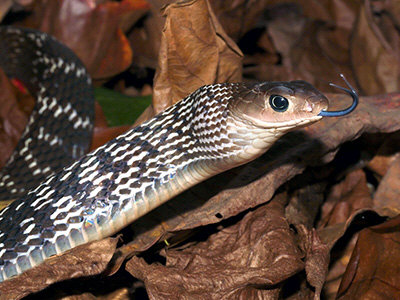 |
Family : COLUBRIDAE
Species : Ptyas carinata
Maximum Size : 4.0 metres
The Keeled Rat Snake
occurs in a variety of lowland habitats, but appears more common in
secondary forest and sparsely wooded, agricultural areas. It is less common
in primary forest, seeming to prefer forest-edge habitats.
This is by far the largest of the rat snakes of the Ptyas genus,
reaching an impressive 4 metres total length. From a distance this snake
could easily be confused with the King Cobra
Ophiophagus hannah.
The body is of moderate thickness, somewhat triangular in cross-section, and
the head is wider than the body. The eyes are very large.
The front part of the body is dark brownish grey, sometimes with faint pale
barring, the middle part is black and cream in a distinctive chequered
pattern, and the posterior part is predominantly cream with scattered
black-edged scales. The tail is mainly black with scattered pale spots, and
the throat is white or cream, grading to dark grey on the belly.
Its diet comprises a variety of rodents and large frogs, hence its
occurrence in agricultural areas.
This impressive rat snake ranges from southern China through Myanmar,
Thailand, Vietnam, Peninsular Malaysia and Singapore to Sumatra, Java,
Borneo and the Philippines.
Fig 1 : Specimen from Singapore's central forests. Photo thanks to
Noel Thomas.
Fig 2 : Specimen from buffer forest, surrounding Bukit Timah, Singapore. Despite its size, this 3-metre specimen
attempted to conceal itself in the undergrowth after being disturbed.
Fig 3 : The front part of the body is brownish-grey.
Fig 4 : The middle part of the body is strongly patterned
in black and cream.
Fig 5 : The rear section of the body is predominantly cream.
References :
Das, I., 2010. A Field Guide to the Reptiles of South-east Asia. New
Holland Publishers (UK) Ltd.
Tweedie, M., 1957. The Snakes of Malaya. Raffles Museum, Singapore.
|